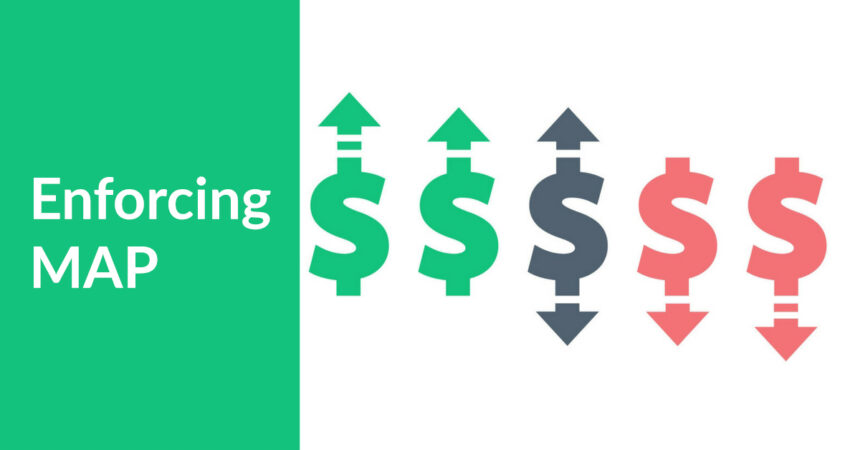
In the age of brick and mortar retail stores, MAP or Minimum Advertised Price used to to be a safeguard for manufacturers. Let me explain with an example. Suppose you are a manufacturer of pumps. Your cost to manufacture each pump is around 20 USD. You sell them to a retailer at $30 each. He, in turn, sells a hundred of those at $35 each. Because of some reason he is left with 5 remaining pieces. It is the festive season. He advertises (and sells) these remaining pumps at only $25 each. He does make a loss on these five pumps but he makes an enormous profit on the whole set, and since more customers throng to his shop to get the steeply discounted pumps, they end up buying more things alongside, and overall things go in favor of the retailer.
But, by now everyone thinks that your pump was priced too high initially and something around $25 should be its real selling price. You are doomed. No retailer is willing to buy your pumps at $30 since even customers would not pay that amount to buy those pumps. All because a seller advertised and sold those pumps too cheap to attract customers and clear his lot at the same time. To prevent such an activity, and to give power to manufacturers to prosecute sellers, MAP keeps retailers from advertising items at a price below an amount specified by the manufacturer. What you need to keep in mind here, is that a seller can very well sell an item below MAP, but he cannot advertise it below the MAP. This maintains a proper idea of the basic price of any item in the customer’s mind.
The conflict in the MAP
Things are not so simple with online retail in the present day. E-commerce websites are notorious for such activities – sometimes they don’t show any price in the product page. Instead, they are displaying a message saying that the price will be displayed once you add the product to the cart. Once the product is added to the cart and the person goes to the checkout window, he can see the real price that he has to pay for that particular item. The problem with this is that websites claim in this way they are not advertising an item below MAP, merely selling it. Add to this, the brick-and-mortar retailers argue that they couldn’t possibly give ads in newspapers asking people to come to their shops to check out real prices of goods. And in this case, they are probably right.
In fact, keeping online sellers in check is pretty difficult, since most websites like Amazon list the same products by different sellers. Now, each seller might choose his own price. One might very well be below the MAP. What do you do next? In such cases, actions taken by the manufacturer become more of a punishment than a deterrent. The manufacturer refuses to sell to that re-seller anymore. However, the effect of even a few unauthorized sellers listing your items below MAP might have a ripple effect on the entire market, even affecting authorized sellers. However, trying to strictly enforce an unreasonable MAP may render your product unsalable even though it might be of great quality.
It is very important that you enforce MAP so that the value of your products don’t decline in the minds of customers, because these days, even offline shoppers check out online prices before committing to a price. Web scraping can be used to extract details from web pages, and since brick and mortar stores would almost never dare to advertise in print media a product below MAP (it would leave behind incriminating evidence trail), you can only focus on online sellers, to make sure a reduced MAP does not erode your brand value.
So how can you use web scraping to enforce Minimum Advertised Price?
Well here are a few ways that PromptCloud helps businesses make sure that their products are not being advertise below MAP-
Scrape popular e-commerce websites to check prices
Getting a list of the most popular e-commerce sites should not be a difficult task. Once you have made a list of them, you can get web crawling solution providers like PromptCloud can build a scraping solution to help you to automatically search for your products in each of the sites that you listed, and then crawl the prices from each website. It can be done in such a way that the website, product, and price can come in three columns of an spreadsheet. This program can be run by you daily, so as to keep a check on the advertised prices of your products in all leading and popular websites.
Check for multiple prices by different sellers
Another factor that you need to keep in mind is that, even though a price is quoted beside an item listed in a website, on clicking a button (generally labeled as “show more prices”), you can also see prices by other sellers which might or might not be verified sellers of that e-commerce platforms. So while scraping the prices, you need to crawl prices from more than one seller, wherever they exist. This is because many small sellers will generally hide under this button to save themselves from getting caught in MAP violations.
Search and crawl top listings in price comparison sites
Most price comparison sites aggregate and display products from eCommerce portals on their site and it makes for a great place to find your product prices at multiple sites together. So you can actually search for your products by full name as well as closely matching words, to find the prices being quoted in these listings since they are viewed by thousands of people every day. Doing this for hundreds of items across tens of ecommerce portals is a herculean task, and can only be properly undertaken if you have a proper intelligent web-scraping system built in place.
Nowadays, many websites put up banners and advertisements on their websites, to advertise upcoming sales. In these sales, some specific products are advertised at outrageously low prices (although they are available in limited amounts are only sold in first come first serve basis). This is done to attract more customers and boost overall sales. However, in case your products are one of those advertised, it might damage your brand image. So you could go for ad scraping and crawl banners from popular sites on a regular basis to make sure that none of your products are being advertised below the MAP.
Forcing sellers to stick to your MAP wouldn’t work, unless you follow basic unwritten rules such as not selling an item at highly inconsistent rates to different resellers and quoting exorbitant MAP that wouldn’t sell in current markets. You have to walk a mile so that the online and offline resellers can walk one too, and you can meet in the middle. Only then can you safely sell your products both in brick and mortar stores as well as online, without worrying about your items being undersold, or advertised at a price well below the MAP. When you want to make sure your MAP is respected, you can always seek help from a reputed web scraping service like PromptCloud.



















